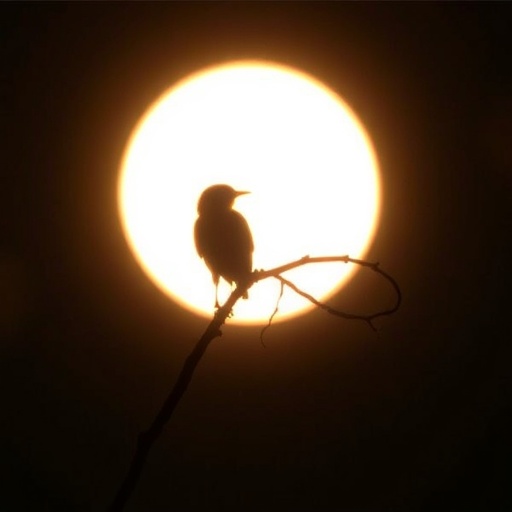Total solar eclipses are rare phenomena that captivate both the scientific community and the general public. These celestial events are an opportunity for researchers to study the impacts of sudden changes in light on wildlife behavior, specifically avian species. A recent study led by Liz Aguilar from Indiana University focuses on how birds react to short disruptions in light, such as those experienced during a total solar eclipse. This research, featured in the prestigious journal Science, explores how light influences bird behavior and raises important discussions about the effects of urbanized environments and artificial light at night.
The research team’s investigation coincided with the total solar eclipse on April 8, 2024, when the moon’s shadow passed over North America, traversing from Mazatlán to Newfoundland in mere hours. In Bloomington, Indiana, the eclipse lasted just over four minutes, providing a unique opportunity to observe avian behavior during this brief period of darkness. Aguilar’s team posited that this sudden change in light conditions could trigger behaviors similar to those seen at dawn, including increased singing among various bird species.
Central to their study was the development of the SolarBird app, designed to engage the public in bird observation during the eclipse. By leveraging crowdsourced data, the app allowed users to document bird behaviors in their vicinity before, during, and after totality. This innovative approach enabled thousands of participants to contribute to scientific data collection in real time. As many as 11,000 observations were recorded from over 1,700 users, providing a wealth of information to analyze how birds respond to such unique environmental changes.
The methodology of the study was comprehensive. Participants were prompted to observe birds and report specific behaviors, such as singing, feeding, and flying. The app utilized GPS technology to determine the precise timing of the eclipse in relation to the user’s location, allowing for accurate correlation between the observed behaviors and the eclipse’s phases. Aguilar and her team aimed to make the data collection process accessible to non-experts, minimizing barriers for individuals interested in contributing to scientific research.
Simultaneously, a separate group led by Kimberly Rosvall employed automated recording devices to capture bird vocalizations in Bloomington and surrounding areas in the lead-up to the eclipse. These recorders, which are compact and unobtrusive, gathered extensive data on bird songs, significantly enriching the study’s findings. By implementing advanced artificial intelligence technology, particularly the BirdNET system, the researchers could analyze nearly 100,000 vocalizations efficiently. This AI-supported analysis was pivotal in identifying patterns and changes in bird songs that correlated with the eclipse.
The results of the study revealed fascinating trends. Approximately 29 species exhibited noticeable changes in vocalization patterns around the time of the total eclipse. Birds that typically engage in a burst of songs at dawn appeared to respond similarly during the eclipsed period, which further emphasizes the depth of their behavioral instincts. This surprising adaptability highlights the intricate relationship between light conditions and avian activity, reiterating the significance of natural rhythms among wildlife.
While the SolarBird app facilitated crowd-sourced data collection, the integration of passive sound recording technology created a comprehensive dataset that combined real-time observations with detailed audio analyses. This dual approach not only enriched the dataset but also demonstrated how collaborative efforts between scientists and the public could enhance our understanding of animal behavior in response to environmental changes.
Notably, both the observational and participatory components of the project showcased the effectiveness of community science in bridging gaps between scientific inquiry and public involvement. Engaging the community through technology not only democratizes the scientific process but also cultivates a sense of connection to nature and scientific inquiry. As Aguilar remarked, this experience not only allowed researchers to gather vital information but also enriched the participants’ experience of the celestial event itself.
The implications of this research extend beyond the immediate findings. Rosvall and her team highlighted how brief disturbances in light—whether caused by an eclipse or by human-induced conditions like urbanization—could significantly affect wildlife behavior. As artificial light pollution continues to rise in urban environments, understanding its impacts on natural behaviors, particularly among sensitive species, becomes increasingly critical.
Throughout the study, the collaborative nature of the project amplified its success. Researchers from diverse fields came together, combining expertise in animal behavior, technology, and public engagement to address a compelling scientific question. Such interdisciplinary approaches are essential when tackling complex ecological issues, as they foster a holistic understanding of the factors influencing wildlife behavior.
As scientists reflect on the project’s outcomes, they express hope that such innovative and collaborative research models will encourage further exploration into the interplay between natural phenomena and wildlife behavior. The successful blending of technology, community involvement, and scientific inquiry serves as a blueprint for future studies aimed at understanding the effects of environmental changes on diverse species.
Ultimately, the research conducted during the total solar eclipse not only sheds light on the behavior of birds but also inspires a renewed appreciation for the intricate connections between the cosmos and life on Earth. Harnessing the enthusiasm for such celestial events can spark broader conversations about conservation, urban development, and the importance of preserving natural habitats amid the encroaching influence of artificial light.
In summary, the implications of Aguilar’s study underscore the significance of exploring the nuanced interactions between wildlife and their environments. By leveraging technology and community engagement, researchers can tackle pressing ecological questions while fostering a deeper connection between the public and the natural world.
Subject of Research: Animals
Article Title: The importance of light for bird behavior, as revealed by community science and the 2024 eclipse
News Publication Date: 9-Oct-2025
Web References: DOI Link
References: Research methods include observational studies and AI-supported analysis.
Image Credits: Photo by James Brosher, Indiana University
Keywords
Environmental sciences, Behavioral ecology, Observational studies




